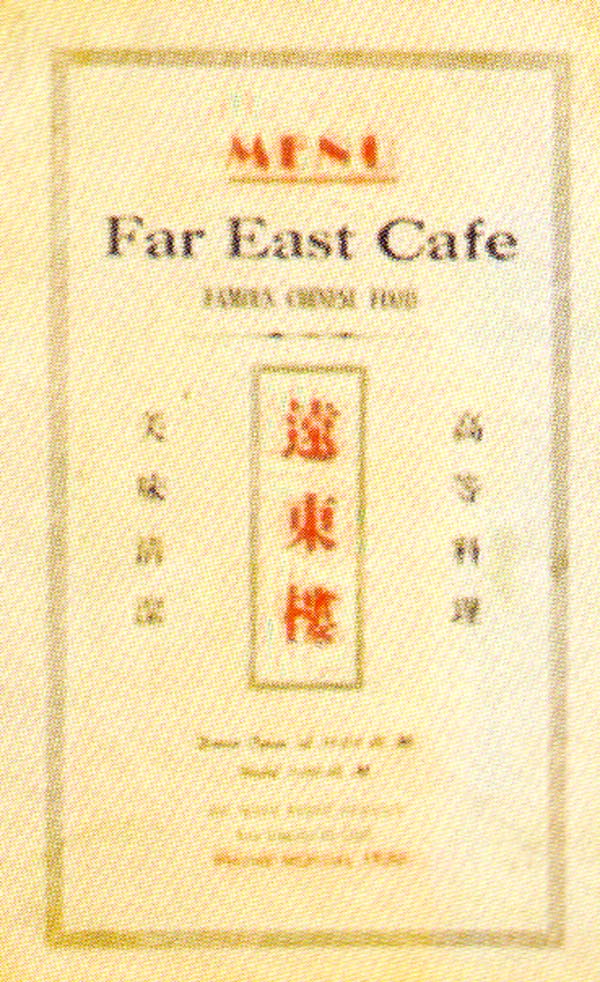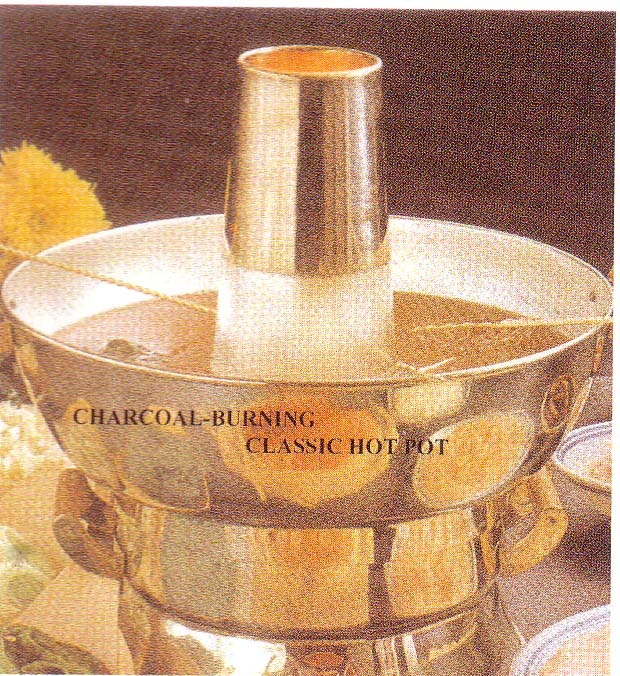
| What is Flavor and Fortune? |
| How do I subscribe? |
| How do I get past issues? |
| How do I advertise? |
| How do I contact the editor? |
Read 13151943 times
Connect me to:
| Home |
| Articles |
| Book reviews |
| Letters to the Editor |
| Newmans News and Notes |
| Recipes |
| Restaurant reviews |
| Article Index (all years, slow) |
| List of Article Years |
| Article Index (2026) |
| Article Index (last 2 years) |
| Things others say |
| Related Links |
| Log In... |
| Authors |
| Categories & Topics |
TOPICS: Far East Cafe Dishes; Hot Pot
| by Jacqueline M. Newman |
Newman's News and Notes
Summer Volume: 2009 Issue: 16(2) page(s): 10 and 11
 FAR EAST CAFE, in the article appearing in Volume 16(1) on pages 15, 16, and 17, unfortunately required a last minute cut. Our apologies to Raymond Chong and Toni Osumi. The dishes served at the reunion at this restaurant in Little Tokyo were omitted. Enjoyed by all attendees, they brought fantastic memories. For those who want to know what they were, here is the list of them.
FAR EAST CAFE, in the article appearing in Volume 16(1) on pages 15, 16, and 17, unfortunately required a last minute cut. Our apologies to Raymond Chong and Toni Osumi. The dishes served at the reunion at this restaurant in Little Tokyo were omitted. Enjoyed by all attendees, they brought fantastic memories. For those who want to know what they were, here is the list of them.
Tofu Seaweed Soup: A lighter version than the pork-based seaweed soup we grew up with, yet still very tasty. Ribbons of seaweed, swirls of egg white, cubes of tofu and the crunchiness of Chinese pea make this a worthy successor.
Cha Shu: Sliced one-quarter inch or thinner and served wet with a sweet and salty sauce was great spooned on the rice. It was not what old timers were expecting, the thick cut and sometimes dry cha shu of yesteryear.
Baby Bok Choy with Black Mushrooms: A very generous portion of whole black mushrooms, firm baby bok choy, and a light clear sauce made this dish.
Chop Suey: Nothing like the overcooked and often bland versions of the past. This one was colored brightly with oranges and greens and seasoned just right.
Sweet and Sour Pork: Dressed in electric red sauce with pineapple chunks and green and red peppers. This sweeter dish helped round out the meal even though it was not my grandmother's version of pork on the bone. It had a bit more vinegar and was without the artificial dye.
Almond Duck: Many people considered this the best. It was formed into a oblong patty and made of duck meat, flour, cornstarch and spices, deep fried, cut into squares, and served over a bed of lettuce. It arrived topped with gravy and chopped almonds.Hom Yu: A large patty with cilantro accents had more pork than fat, some salted fish, and salted egg.
 HOT POT recorded information can be found from the early Jin Dynasty times (265 - 420 CE). This type of cookery may have been popular earlier because cauldron or large pot cookery is as ancient as can be. Use of the hot pot (though not called that then) continued during the Southern and Northern Dynasties (420 - 579 CE), the Sui (581 - 618 CE), Tang (618 - 907 CE) and the Five Dynasties and Ten Kingdom's periods (902 - 979 CE) and on into the Song, Liao, Jin, Yuan, Ming, and the last of the dynasties, the Qing Dynasty that ended in 1911 CE.
HOT POT recorded information can be found from the early Jin Dynasty times (265 - 420 CE). This type of cookery may have been popular earlier because cauldron or large pot cookery is as ancient as can be. Use of the hot pot (though not called that then) continued during the Southern and Northern Dynasties (420 - 579 CE), the Sui (581 - 618 CE), Tang (618 - 907 CE) and the Five Dynasties and Ten Kingdom's periods (902 - 979 CE) and on into the Song, Liao, Jin, Yuan, Ming, and the last of the dynasties, the Qing Dynasty that ended in 1911 CE.
Records indicate that the Emperors and their royal families were served cook-at-the-table foods frequently. Less information, but recorded nonetheless, though in less detail and less often shows that common people used them, as well.
Hot Pot was used most often during the winter months, sometimes spoken of as 'eating hot dishes.' These were simply not hot foods but were described indicating how they were consumed. Cooking in hot stock or soup was a good way, especially for those in northern climates, to enjoy food at appropriate temperatures counteracting winter cold.
During the time of the Yuan Dynasty (1271 - 1368 CE), it is said that Mongolian soldiers cooked and ate beef and mutton in soup because they had little to no time to prepare more complex meals. They simply boiled their food in the soup before going to battle.
During the Qing Dynasty, one source (in the Palace Maid's Memoirs by Jin Yi) says that "starting from the 15th day of the 10th lunar month, a hot pot was added at every meal, the content varied from mixed ingredients to instant-boiled sliced mutton. People from the Northeast China preferred to eat pickled vegetables, blood, intestine, boiled pork without sauce, sliced chicken without sauce, and sliced stomach all mixed together. We ate this hot pot most often. Sometimes, we also ate pheasant. Anyway, we ate hot pot for three months every year. The hot pot was replaced by the earthenware pot on the 16th day of the first month."
Empress Dowager Cixi was served and it is said she loved hot pot dishes. She even created a famous one now called 'Chrysanthemum Hot Pot.' It is written that it had chicken and pork bones as the stock. The Empress cooked slices of chicken or fish in this broth which had added chrysanthemum flower petals providing a lovely aroma.
Some well-used hot pots, though a small part of their collection, are those used by royal folk, now reside in the Palace Museum. They indicate who made them and who used them. Some of those on display are from the Liao to the Qing Dynasties.
Hot pots and their accessories can include the pots themselves, their lids and chimneys and fire chamber covers, and the metal base plate they sat on. It was customary to inscribe the name of the person(s) who made them, and most of the early ones are so marked. Some also have the name of the workshop where they were made.
The more beautiful ones are decorated with plant, animal, or character inscriptions. The four characters (also found on many older Chinese dishes) are most commonly for longevity, good luck, wealth, and long life. The hot pots on display are made of gold, silver, copper, tin, and iron, many tinned on their interiors. Some exhibit expert craftsmanship, a few with less than perfect designs.
Early hot pots heated the soup with charcoal. That is frowned upon today. With houses more tight than ever before, a word of warning: Do not use charcoal because the limited supply of oxygen will rapidly be depleted and safety in a home rapidly compromised. That can explain why newer hot pots are electricity. For more information about these cooking devices, recipes too, do see Flavor and Fortune's, Volume 7(4) on pages 11 and 12, and Volume 8(1) also on pages 11 and 12.

Copyright © 1994-2026 by ISACC, all rights reserved
Address
3 Jefferson Ferry Drive
S. Setauket NY 11720